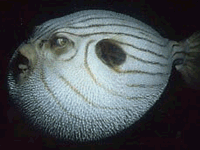

There is evidence that tetrodotoxin-contaminated seafood is spreading northwards – it has even been found off the southern coast of England. Pufferfish are not the only species that can accumulate tetrodotoxin in this way. Rather, it is a product of environmental bacteria that accumulate in the fish. The poison is not produced by the fish itself. Clearly, messages about the dangers of this fish have not been getting through. A recent survey found that 38% of surveyed fishermen had consumed pufferfish and of that group, 11% had shown symptoms of intoxication. There is no market for pufferfish as a delicacy in Turkey but the fishermen often eat the fish they catch because they can’t sell it elsewhere.
#Fugu blowfish full#
The treatment is very successful, with many people making a full recovery.

There is no antidote and treatment is to support breathing artificially until the body excretes the toxin naturally. It kills because nerves no longer trigger muscle movement controlling breathing and the victim suffocates. In the body, tetrodotoxin blocks sodium channels that enable nerves to fire. It is far more potent a poison than arsenic or cyanide. This powerful neurotoxin, when pure, can kill an adult human at a dosage of as little as two milligrams. Tetrodotoxin is found in several of the silver-cheeked toadfish organs, including the ovaries and liver. The other concern is the toxicity of the fish. The financial losses to fishermen, who are already often on very low incomes, have been increasing in recent years. The damage to fishing gear is one thing, but the toadfish will then go on to feast on the abundance of food it finds inside the nets, meaning several kilos of the catch are often unsaleable. The silver-cheeked toadfish has strong teeth that it can use to bite through fishing lines and nets to get to the trapped fish. The main cause for concern is its economic impact. The toadfish appears to be thriving off the Turkish coast and is of particular concern for several reasons. One of the invading species, the silver-cheeked toadfish ( Lagocephalus sceleratus), is a type of pufferfish most usually found in the Pacific and Indian oceans. Migration of species in the opposite direction is relatively rare because the Red Sea is comparatively saltier and nutrient poor. It also brought with it invasive species from the Red Sea: 925 non-native species have been recorded in the eastern Mediterranean since the opening of the canal. The Suez Canal when it opened in 1869 brought dramatic changes to world trade. Relatively recently, the fish have arrived in the eastern Mediterranean. The fish has also invaded new territories in recent years posing new problems, especially for fishermen not familiar with the species. However, pufferfish are widely distributed in tropical waters – and those consumers and those fishing outside Asian countries aren’t always aware of the dangers. A package of pufferfish containing the potentially deadly liver, top right.


 0 kommentar(er)
0 kommentar(er)
